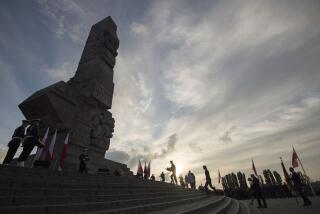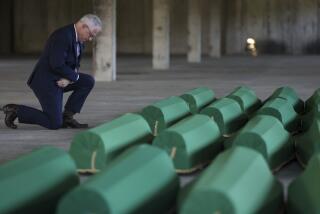Team Exhumes Evidence at ‘Killing Fields’ in Bosnia
- Share via
BRCKO, Bosnia-Herzegovina — A white United Nations bulldozer heaves across a now-vacant field, maybe an acre in size. Tons of dirt and rubble are piled to one side--the likely remnants of a mosque and Muslim homes.
On the outskirts of this Serb-held town, war crimes investigators have embarked with unusual secrecy on their first exhumation this year of a wartime mass grave.
The exhumation will be used to bolster the case against two Serbs accused of running a detention camp in Brcko, in northeastern Bosnia-Herzegovina, where hundreds of Muslims and Croats were rounded up and killed or expelled at the start of the war in 1992. One of the two leaders of the camp frequently called himself the Serbian Adolf, according to an indictment by the international war crimes tribunal.
The dig in Brcko, kept secret until Tuesday, comes as international officials are taking a tougher stand on suspected war criminals. NATO’s arrest earlier this month of one suspect and killing of another who resisted arrest have heightened tensions, especially among Bosnian Serbs, who are the target of most war crimes indictments and have retaliated with a campaign of grenade and dynamite attacks against foreigners.
Evidence from the Brcko site may be used to put together additional indictments, international officials said.
One unindicted suspect who allegedly helped direct the “ethnic cleansing” of Brcko was “Arkan,” the most notorious of Serbian paramilitary leaders and a onetime confidant of Yugoslav President Slobodan Milosevic. Eyewitnesses have said that Arkan, whose real name is Zeljko Raznjatovic, was in Brcko regularly during that period. He has denied all such accusations.
There may be as many as a dozen mass graves in the fields just west of Brcko, each with 25 or more bodies, according to Mirsad Dzapo, a Muslim official in Brcko’s “government in exile” who escaped the town as it fell to Serbian forces.
Houses occupied by Serbs are just a few hundred yards away from the site where the tribunal team has begun work. They are visible over treetops. Barbed wire surrounds the field, which the tribunal, based at The Hague, has declared off limits to the media.
U.N. spokesman Alexander Ivanko confirmed at a news conference Tuesday in Sarajevo, the capital, that the exhumation was in progress.
On Monday, a bulldozer was clearing dirt at the site, and blue tarps were laid on the ground. The site is only about 200 yards off a main highway.
Ivanko said the unusual secrecy was intended to protect the “integrity” of the investigation. Other officials said there was concern about the safety of the team of 25 archeologists, pathologists and doctors working at the site. Troops of the North Atlantic Treaty Organization are providing only nominal security.
Last year, the exhumations of four mass graves believed to be connected to the massacre at Srebrenica were near-public events. But officials believe the danger may be greater now because the indicted suspects from Brcko are still at large and able to move about relatively undetected because they are not well known.
Thus far, a couple dozen bodies have been extracted after nearly a month’s work, international officials said. Investigators on the scene said they had to remove several hundred tons of rubble and dirt to reach the remains.
Much of the rubble was from a mosque and Muslim homes razed by the Serbs who seized control of the riverfront town in April 1992, according to people familiar with Brcko.
According to the Hague tribunal’s indictment, hundreds of Muslims and Croats were detained and crowded into the so-called Luka Camp, where they were tortured and raped, and many were killed. Survivors have said the camp was run by two men named in the indictment: Goran Jelisic, now 29, a mechanic who called himself the Serbian Adolf; and Ranko Cesic, 33.
During a two-week period in May 1992, the indictment says, “almost every day . . . [Jelisic and Cesic], often assisted by camp guards, entered Luka’s main hangar where most detainees were kept, selected detainees for interrogation, beat them and then often shot and killed them . . . usually at close range in the head or back.
“Often, [Jelisic and Cesic] and camp guards forced the detainees who were to be shot to put their heads on a metal grate that drained into the Sava River, so that there would be minimal cleanup after the shootings.”
Both men are charged with crimes against humanity and violations of the customs of war, and Jelisic is also charged with genocide.
More to Read
Sign up for Essential California
The most important California stories and recommendations in your inbox every morning.
You may occasionally receive promotional content from the Los Angeles Times.














